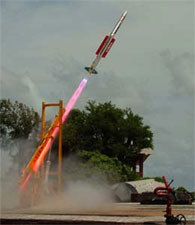|
Balasore: India on Monday conducted two rounds of back-to-back tests of its prestigious 'Astra' Beyond Visual Range Air-to-Air Missile (BVRAM) from the Integrated Test Range (ITR) facility off the Orissa coast. Once operational, this sophisticated weapon will allow India to join a small league of countries, such as the US, Russia, France and Israel that possess such technologies.  Defence sources said the missile was launched from a specially-built ground launcher and the tests were a success. ''The missile covered the desired distance as coordinated. It hit two simulated targets and met all the mission objectives. The tests were aimed at checking the control system and its stability,'' ITR director SP Dash said. Defence sources said the missile was launched from a specially-built ground launcher and the tests were a success. ''The missile covered the desired distance as coordinated. It hit two simulated targets and met all the mission objectives. The tests were aimed at checking the control system and its stability,'' ITR director SP Dash said.
Sources said the missile covered about 20 km in these tests. The 'Astra' is meant to take on targets at 80-km range in head-on mode and 20 km range in tail-chase mode. It is designed to intercept fast-moving aerial targets at supersonic speeds (1.2-1.4 Mach). Last year, in November, the Defence Research and Development Laboratory (DRDL), the lead lab in the development of 'Astra' had carried out captive flight trials of the missile on-board Sukhoi-30MKI aircraft at Pune. ''Now, the ground tests have also proved successful. The missile is expected to go for integrated trial within a year,'' Dash added. The 'Astra' is a single-stage, smokeless, solid-fuel propelled missile. The missile will be inducted for use onboard a variety of aircraft, such as the Jaguar, the MiG-29 and the Tejas light combat aircraft, as well as top-of-the-line fighters such as the Mirage 2000 and the Sukhoi-30MKI. Defence scientists say that the missile's unique capabilities make it a more complex weapon than even the nuclear-capable Agni series of strategic ballistic missiles.
|